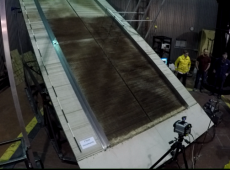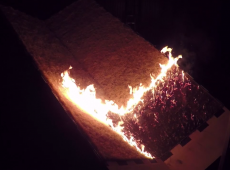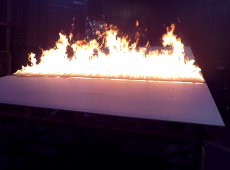A large tilting burn table permits fire experiments on sloping topography. The table consists of an elevated platform 12’ X 20’ that tilts from 0 to about 45 degrees by means of a hydraulic ram. The platform has several possible configurations, including the flat planar table for populating with various fuel materials and study of spreading fires (see pictures), a folding surface for examining fire behavior on canyon-type topography, and a 4’ X 12’ gas burner assembly that allows study of flame structure from well controlled stationary rectangular burner.
The rectangular burner consists of 8 burner tubes 12’ long running across the fuel bed. The flow rate of propane or other gas can be regulated by mass-flow controllers for an arbitrary configuration of burner tubes, making it possible to control flame zone depth, flame zone width, energy release rate, and spatial variations of these from within the bed. Thermocouple measurements are an important means of characterizing the flame temperature profile uphill, the radiant flux as a function of burner configuration, and the effect of flame front geometry in changing heat transfer from a line fire.


